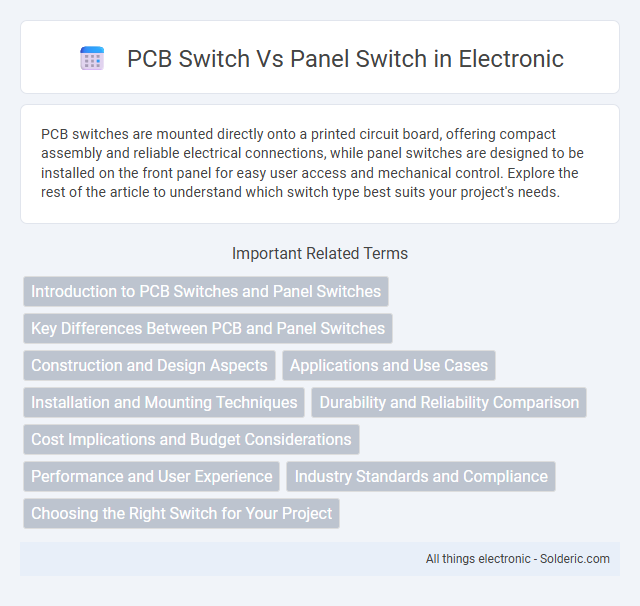PCB switches are mounted directly onto a printed circuit board, offering compact assembly and reliable electrical connections, while panel switches are designed to be installed on the front panel for easy user access and mechanical control. Explore the rest of the article to understand which switch type best suits your project's needs.
Comparison Table
| Feature | PCB Switch | Panel Switch |
|---|---|---|
| Mounting Type | Mounted directly on PCB (Printed Circuit Board) | Mounted on front panel or enclosure |
| Installation | Soldered or surface-mounted on PCB | Installed via panel cutout with fastening hardware |
| Size | Compact, optimized for PCB layouts | Usually larger for user accessibility |
| Application | Internal device control and circuitry switching | User interface and external control |
| Durability | May have lower mechanical robustness | Designed for frequent manual operation |
| Examples | Tactile switches, slide switches on PCBs | Toggle switches, rotary switches, pushbuttons on panels |
Introduction to PCB Switches and Panel Switches
PCB switches are electronic components mounted directly on printed circuit boards, enabling compact and reliable control within electronic devices. Panel switches, by contrast, are installed on the exterior panels of equipment, providing accessible user interface control for operational commands. Understanding the distinct mounting and functional roles of PCB switches and panel switches helps optimize your device's design and usability.
Key Differences Between PCB and Panel Switches
PCB switches are mounted directly onto printed circuit boards, providing compact integration and automated assembly in electronic devices, while panel switches are installed on device exteriors for user interface control and tactile feedback. PCB switches typically offer lower profiles and faster electrical connectivity, whereas panel switches prioritize durability and ergonomic design for frequent manual operation. The choice depends on application requirements, with PCB switches suited for internal signal control and panel switches favored for user accessibility and mechanical robustness.
Construction and Design Aspects
PCB switches feature compact designs integrated directly onto printed circuit boards, utilizing soldered contacts and compact actuators for efficient electronic control. Panel switches emphasize robust construction with larger, ergonomic actuators mounted on control panels, often incorporating mechanical or tactile feedback for user interaction. Your choice depends on whether you prioritize space-saving PCB integration or durable, user-friendly panel operation in your device.
Applications and Use Cases
PCB switches are ideal for compact electronic devices such as keyboards, remote controls, and small appliances where space efficiency and reliable circuit integration are crucial. Panel switches are commonly used in control panels, industrial machinery, and automotive dashboards because they offer easy accessibility and durable operation in harsh environments. By choosing the right switch type, you can ensure optimal performance tailored to your device's specific application and user interface requirements.
Installation and Mounting Techniques
PCB switches are designed for direct soldering onto printed circuit boards, providing precise electrical connections and compact integration within electronic devices. Panel switches, however, are mounted through holes or cutouts on panels, secured with nuts or clips, allowing for easy manual access and replacement. Your choice depends on whether seamless circuit integration or accessible external control is prioritized in the installation environment.
Durability and Reliability Comparison
PCB switches typically offer higher durability due to their robust soldered connections on the printed circuit board, reducing the risk of contact failure over time. Panel switches, mounted directly onto device enclosures, may experience increased wear from mechanical stress and environmental exposure, potentially lowering long-term reliability. In high-use or industrial applications, PCB switches are generally preferred for their consistent performance and resistance to mechanical degradation.
Cost Implications and Budget Considerations
PCB switches typically offer lower manufacturing costs due to automated assembly and reduced material usage, making them ideal for budget-conscious projects. Panel switches, while generally more expensive, provide enhanced durability and tactile feedback, which can justify their higher price in applications requiring robust user interfaces. Budget considerations must weigh initial switch costs against long-term maintenance and performance requirements to determine the most cost-effective option.
Performance and User Experience
PCB switches offer faster response times and higher durability due to direct soldering onto circuit boards, enhancing overall performance in precise electronic applications. Panel switches provide greater versatility in design and ease of replacement, contributing to a more customizable user experience in control interfaces. Both switch types affect tactile feedback and reliability, with PCB switches favoring consistency and panel switches offering adaptability.
Industry Standards and Compliance
PCB switches conform to industry standards such as IPC-2221 for PCB design and IEC 60669 for switch safety, ensuring reliable integration within electronic circuits. Panel switches adhere to UL 508 for industrial control panels and NEMA ratings for environmental resistance, guaranteeing durability and compliance in harsh operating conditions. Both switch types require compliance with RoHS and REACH regulations to meet global environmental and safety standards.
Choosing the Right Switch for Your Project
Choosing the right switch for your project involves understanding the key differences between PCB switches and panel switches. PCB switches are designed for direct mounting on printed circuit boards, offering compact integration and reliable electrical connections, ideal for internal device controls. Panel switches, mounted on device enclosures, provide robust user interfaces with tactile feedback and ease of access, making them suitable for interactive controls where user experience is critical.
PCB switch vs Panel switch Infographic

 solderic.com
solderic.com